The use of succinic acid for orchids: preparation of a solution, rules for watering and processing
Houseplants need love and care. In order for the flowers to please the hostess for a long time, it is not at all necessary to buy expensive means and fertilizers. It is enough just to know some secrets, one of which is succinic acid.
This article will tell you how to apply and use succinic acid for the beauty and health of orchids, as well as the features of this treatment.
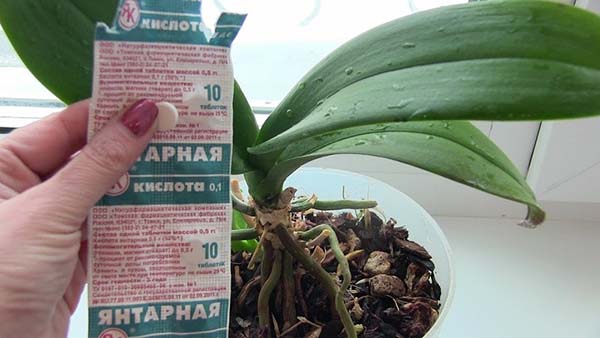
Content
What is succinic acid
Succinic acid is a simple and affordable agent that is widely used to stimulate the growth of many crops (especially indoor plants). This substance has a chemical name - dicarboxylic acid. It has the form of translucent crystals that are soluble in water, ether or alcohol.
This substance is produced from amber and is used in both horticulture and medicine. It tastes vaguely like citric acid.

In what forms is it sold
It is believed that using pure (crystalline) succinic acid is the most beneficial option for orchids.
In its pure form, you can find it in flower and garden stores.
But the simplest and most convenient forms are pills or sachetscontaining a ready-made powder sold in pharmacies (without a prescription).

When purchasing a substance from a pharmacy, it is important to know that this form is made for people, therefore has a number of impurities, such as ascorbic acid, sugar, glucose, potato starch, talc and many others. Of course, these impurities can harm the plant, but not in such scanty amounts.
Note! One tablet weighing 0.5 grams of active ingredient (succinic acid) contains only 0.1 grams.

Note! However, there is an alternative opinion about the use of YaK in tablets for orchids, expressed in the following video. In short, these are pills for the human body. You need to fertilize plants with special fertilizers. If succinic acid is used, then only in its pure form - crystalline, and not in tablets!
Video: succinic acid tablets - is it worth using it for the resuscitation of orchids
What are the benefits of using succinic acid for orchids
These beautiful flowers from the orchid family (orchids) are ancient plants that have come down to us from the late Cretaceous era. They have delicate bright bizarre inflorescences.
Orchids need a moist environment. In order to pick up moisture from the air, they release aerial roots. It is worth recognizing that this type of indoor plants is quite whimsical, but with certain knowledge and skills of a florist, it can bloom luxuriantly and please the eye.
However, if you notice that something is wrong with your orchids, or you want them to withstand the transplant better, then the use of succinic acid will make it much easier for them to cope with stress, adapt and grow.
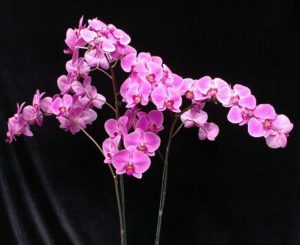
Benefits and Potential Harm
The benefits of succinic acid for orchids are enormous. The main advantages of this tool are its natural origin (environmental friendliness) and availability (cheapness).
By the way! Succinic acid is a very good helper for all indoor plants (not just orchids).
Succinic acid has the following positive effects on plants (including orchids):
- stimulation of growth and formation of new roots;
- improves the formation of ovaries - increases the number of flowers and the duration of flowering (in other words, stimulates flowering);
- helps the plant to better absorb nutrients from the soil and prevents the concentration of harmful components in the soil;
- has a beneficial effect on plant cuttings, i.e. increases the likelihood of their rooting and subsequent development of a young plant (similar to the use of heteroauxin or root);
- restores the immunity of the transplanted plant (used as an anti-stress agent);
- allows you to reanimate a dying plant or restore it after illness (stress);
- helps to cope with adverse environmental conditions and improper care (heat, frost, excessive moisture and drought);
- often used to improve the germination of plant seeds (for pre-sowing treatment);
- stimulates the formation of children in succulents.
Any, even the best, means fraught with potential harm to both plants and humans.However, succinic acid is an environmentally friendly and by no means a potent agent, but biostimulant. Therefore, it actually cannot harm the plant, moreover, the solution does not accumulate in the plant itself and in the soil, because decomposes quickly enough in air and light.
Accordingly, no special precautions are required when preparing and using the solution. Nonetheless
- despite the fact that the substance is harmless, it is still an acid, therefore, it should not be allowed to get into the eyes and mucous membranes;
- when working with acid, it is recommended to wear rubber (latex) gloves and glasses on your hands;
- it is necessary to protect children and pets from it, the drug should be stored in places inaccessible to them.
However, as you understood, succinic acid also has its drawbacks (common to all biological products):
- Do not expect a very quick and downright miraculous result from using the solution. The remedy is enough weak but effective.
- Frequent use of succinic acid solution acidifies the soil.
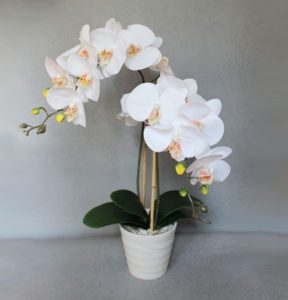
Video: how to revive orchids and other indoor plants with succinic acid
Treatment of orchids with succinic acid
Succinic acid works no worse than living water for indoor flowers. Since orchids have vulnerable roots, which are involved both in photosynthesis and in feeding the trunk and flowers, succinic acid is used for their active growth.
Note! It should be remembered that succinic acid - it is a biostimulant (dietary supplement), not a top dressing, therefore, you should not get carried away with it unless there is a strong need.
Recall that the use of succinic acid has the following beneficial effects on orchids:
- acceleration of growth processes (especially the root system);
- transfer of fertilizers into the form necessary for assimilation by the plant (normalization of the natural microflora of the soil);
- stimulating the release of flower arrows and increasing the splendor of flowering;
- general improvement of the plant.
Succinic acid is most commonly used as an anti-stress agent when boarding and transferring, and for resuscitation of the dying (wasting away from improper care) plants.
The use of succinic acid for orchids is versatile: you can wipe the flower leaves, spray or water (directly on the roots or by immersion).
When can I apply
Note! It is recommended to use succinic acid to stimulate growth and floweringonly during the growing season (spring, summer). You should not use YAK unnecessarily during plant dormancy (after flowering, i.e. in autumn, winter), since it is impossible to stimulate and cause the growth of orchids artificially. Otherwise, in the future, this may adversely affect their development.
Solution preparation
How to dilute succinic acid for orchids?
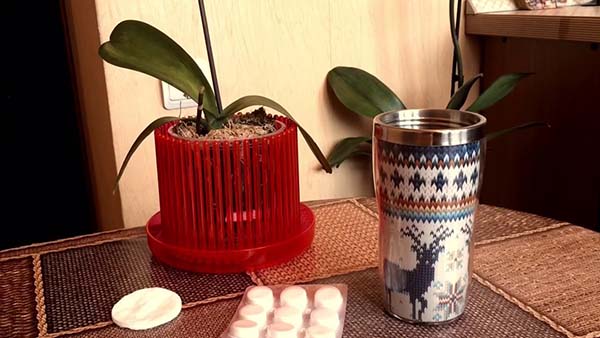
Important! The use of a solution of succinic acid at different times of the year differs in concentration.
To prepare a standard working solution, you mustDissolve 1 tablet (0.1 gram of the active ingredient, the tablet itself can be 0.25 grams and 0.5 grams) in 1 liter of warm water.
Interesting! You can often find a recommendation that it is still better to make a more concentrated solution (Dissolve 0.1 gram of active ingredient in 0.5 liters of water). Since there can be no overdose, in principle, you can use this concentration.
Since the acid dissolves poorly (slowly), initially it is better to crush the tablet and dissolve the resulting powder in a small amount of water (200-300 ml). Then add water to the required volume.
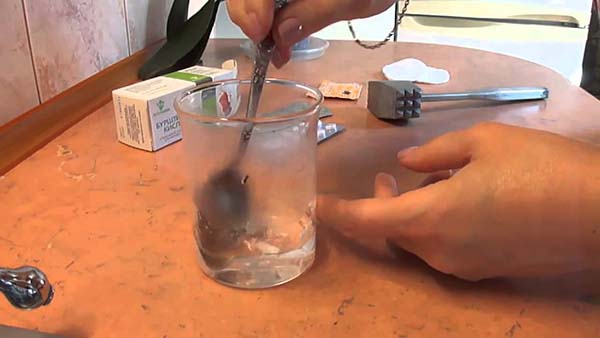
Note! Despite the fact that during the rest period (winter) the use of succinic acid is not recommended, it is still allowed in emergency cases, and the concentration of the solution should be reduced, i.e. 1 tablet dissolves in 2-3 liters of water. At the same time, the treatment itself is best done by spraying from a fine spray (no more than 1-2 times a month).
It must be remembered that a solution of succinic acid for orchids should be cook just before use, since the active substance decomposes rather quickly in air and loses its effect. And here you can store the solution in a hermetically sealed glass container for up to 3 days, always in a dark and cool place.
Important! When preparing any solutions, the correct proportions must be observed, but it is believed that an overdose of succinic acid is impossible, since the plant simply will not absorb the excess concentration!
How to process orchids
So how do you use succinic acid for orchids? There are different processing methods:
For more effect and better results, you can both wipe the leaves and spill the plant's root system at the same time.
- Wipe the sheet plates with a solution.
- Spray the plant with a fine spray (to create fog).
Sprinkling and wiping the leaves are basically the same. It's just that when you manually wipe each sheet, you do it more thoroughly, but noticeably more slowly.
- Water the roots of the plant directly with the solution.
- Immerse (dip) the roots of the plant in the solution.
Next, we will consider in more detail each method of using succinic acid for orchids.
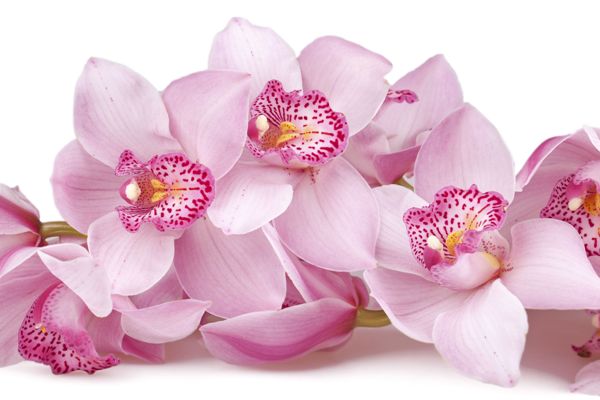
Watering
When watering orchids with a solution of succinic acid, the agent penetrates into the soil, saturates the roots, which means that in this way we can directly stimulate the growth of the root system.
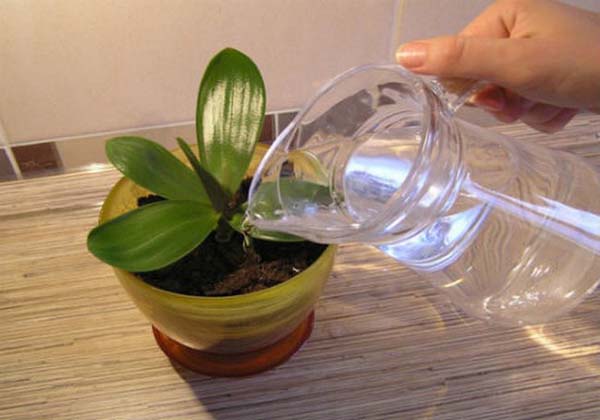
Water the orchid with succinic acid with a standard solution (1 tablet or 0.1 gram of active ingredient per 1 liter, and preferably 0.5 liters of water).
If too much solution has got into the pot, you must wait until it merges into the pan, and then pour it out of there. In no case should the delicate roots of the orchid be allowed to soak, as this can lead to their decay.
We remind you! Watering orchids with succinic acid can only be in spring or summer, that is, during the period of intensive growth (vegetation). In winter and autumn, all processes slow down, the plant rests (dormant period), so it does not need to be artificially stimulated.
Soaking roots
Such a procedure is usually performed to avoid the consequences of severe stress when transplanting a plant or directly when it is under stress due to a change in growing conditions.
If you want to spend immersion irrigation, then just dip the pot in the solution. In this case, it is very important that after processing the solution all flows freely (through the drainage holes). Waterlogging is unacceptable.
When transplanting, soaking the roots of an orchid in a solution of succinic acid can be done as follows:
- clean the roots from the substrate;
- soak (dip) clean roots in a standard solution for 5-10 minutes;
In the case of transplant-resuscitation of a dying plant, the concentration of the solution should be increased by 2-4 times.
- transplant into a new substrate and pot.
Wipe the leaves
By the way! It is believed that foliar (leaf) treatment is much more effective than root, especially for orchids.
Rubbing the leaves is used both in combination (together with watering or immersion in a solution), and for the separate purpose of restoring leaf plates if they droop (began to wither), for example, after reproduction (by dividing the apical part).
There is a specific method and procedure for wiping orchid leaves with a solution of succinic acid:
- Leaf processing is best done in the morning or evening hours.
- To wipe the leaves, soft materials are used that do not injure the plant, for example, a cotton rag, but it is most convenient to use cotton pads.
- Do not squeeze too hard cotton pad, i.e. he must retain a lot of moisture.
- Rub leaves absolutely necessary at both sides.
Advice! It is advisable to remove excess moisture (get wet with something) from the axils of the leaves (from the middle - the rosette of the plant). Otherwise, it is believed that decay of the growth point may begin.However, according to numerous reviews of flower growers, the roots rot from excessive watering, and not from rare treatment with a YAK solution!
- After wiping moisture (solution) should be noticeable on the leaves (small droplets will remain).
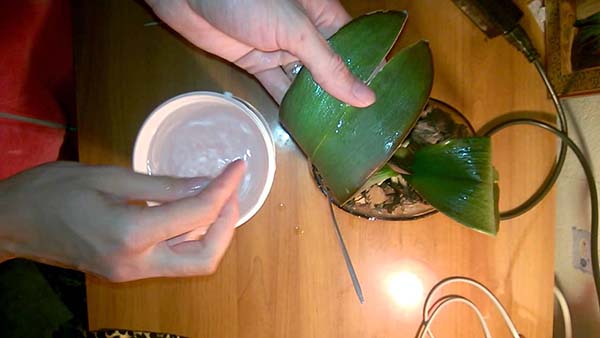
As for how often you can wipe the orchid with succinic acid, it is recommended to do this no more than 1-2 times a week until the desired effect is achieved.
It is worth understanding! If the plant has rotten roots, no manipulation of succinic acid with its leaves will help.
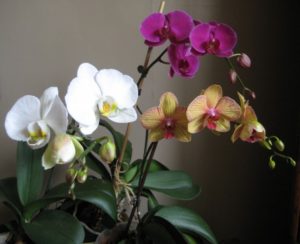
Resuscitation of an orchid without roots with succinic acid
With improper care, namely, excessive watering, the roots of orchids begin to rot, and the plant disappears. In this case, succinic acid will come to the aid in resuscitation of an orchid without roots.
Important! To prepare the resuscitation solution, an increased concentration should be used, in other words, dissolve 2-4 tablets (i.e. 0.2-0.4 grams of active ingredient) in 1 liter of water.
Alternatively, you can apply a moistened cotton pad to the stem of the orchid, where the roots should be, or spray with a spray bottlebe sure to grab the leaves. You need to repeat the treatment every day, in the morning or in the evening, until the roots appear.
During resuscitation, it is very desirable that the roots (or the place where they should be) are open, and the plant itself hangs over a container of water. For example, it can be hung over a tray of raw sphagnum moss (so that it is 1-2 cm up to the plant). Or, alternatively, you can put the moss next to the plant and moisten it periodically. However, this should not be done on the roots, otherwise, due to waterlogging, and they may rot.
This will be a kind of aerial rooting.
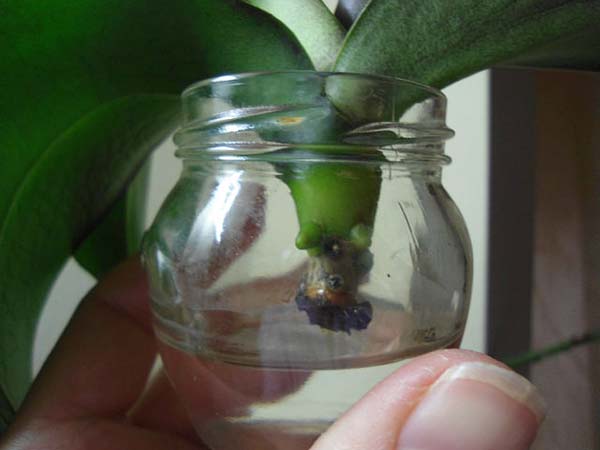
Orchid resuscitation can occur as follows (bysoaking in solution):
- Rotten roots must be removed, and the places of the cuts must be treated with brilliant green or charcoal and dried.
- Prepare a solution and put an orchid without roots in it (only the root collar) for 10-15 minutes (some recommend up to 30 minutes).

- The procedure is carried out every day (or every other day) until the roots appear. The duration of resuscitation is on average up to 2-3 months (if you need strong roots). However, it is possible to plant in a permanent place even with smaller sizes.
Advice! After the resuscitation has successfully passed - new roots appear, it is advisable to immediately transplant the orchid into the most suitable substrate, for example, consisting of sphagnum moss or coconut fiber. It is best to use bark for drainage!
Video: resuscitation of an orchid without roots with succinic acid in 2 parts
Answers to frequently asked questions on the use of succinic acid to treat orchids
Very often, beginner growers ask similar questions about the use of succinic acid. Here are the answers to the most popular ones.
When or in what cases is processing necessary?
Succinic acid is used for orchids in the following specific cases:
It is worth understanding! Succinic acid is just a helper. The main thing is to create favorable conditions for growing and properly care for the plant. That is, first of all, it is necessary to eliminate the cause of the poor health of the orchid, and after that the YAK will help the plant to recover.
- if the plant is well developed and absolutely healthy, but for some reason does not want to bloom (during the growing season);
- for treating a plant under stress (transplanting or changing growing conditions, for example, climate), as well as for improving root formation and survival of cuttings;
- if you notice obvious signs of plant oppression, for example, peduncles do not form or flowering is too sluggish, the leaves are drooping (sluggish);
- for resuscitation of dying plants.
Important! Succinic acid is a biostimulant (dietary supplement) that is used only when it is necessary to restore or urgently help the plant. In other words, you need a good reason to use it.
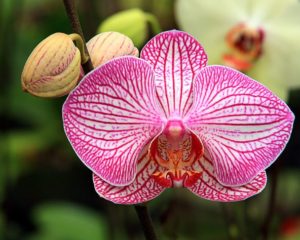
Processing frequency
How often should orchids be processed? If you wipe the leaves, then this can be done 1-2 times a week (for recovery) and 1-2 times a month for prevention. Naturally, watering is often impossible (as a rule, this is done once, for example, during the same transplant).
Of course, it is necessary to carefully monitor the reaction of the plant to the action of the agent. If the effect is achieved, then there is no point in applying further, except for some more time for preventive purposes.
Rememberthat an orchid is a living organism with its own individual characteristics, which a caring owner learns about through constant observation.
What to do in case of overdose and is it possible?
An overdose of this activator cannot happen, because the plant will absorb as much substances as it needs. But in any case, it is required to strictly adhere to the recommended dosages.
Important! It must be remembered that this drug is not a fertilizer. It is a stimulator of all plant processes, and in order for it to bring him maximum benefit, you need to be aware of the rhythm in which the orchid is developing (at what stage it is).
Orchids are wonderful exotic plants that can decorate any home. If your favorite flowers have fallen ill, then the use of succinic acid will help in bringing them back to life. However, it should be remembered that the use of YAK can only help the plant to recover, because first of all the orchid needs to create suitable conditions for it and proper care - watering and feeding.
Video: succinic acid - a green doctor for your orchids

